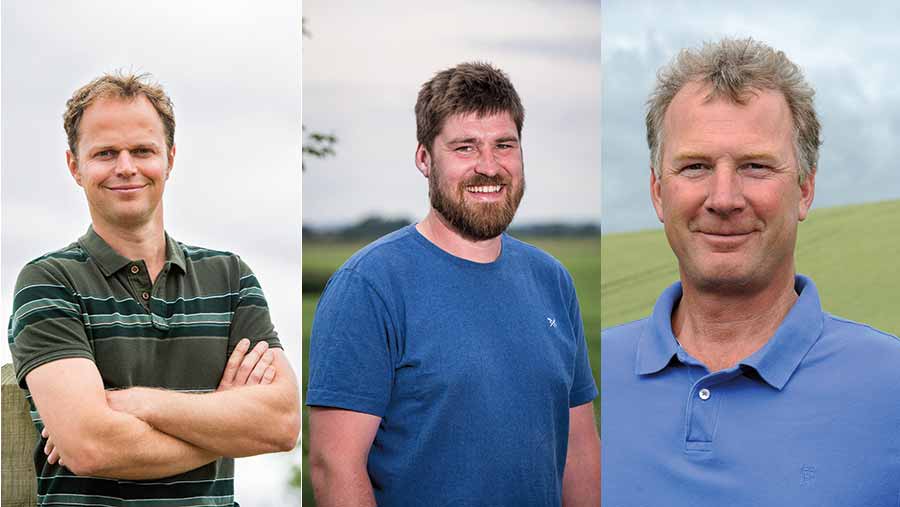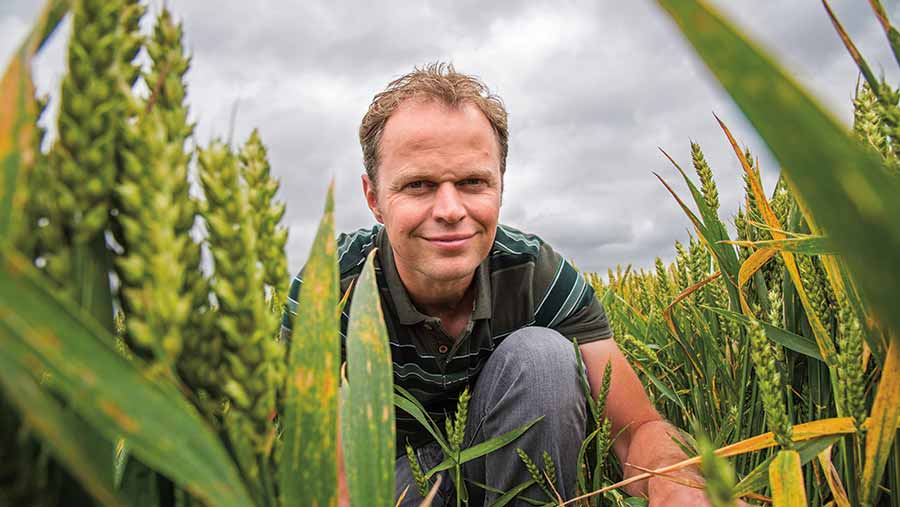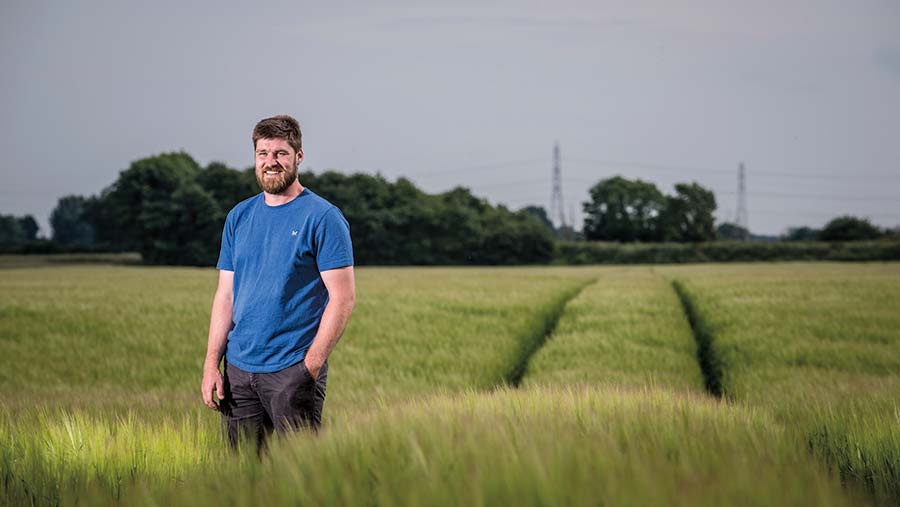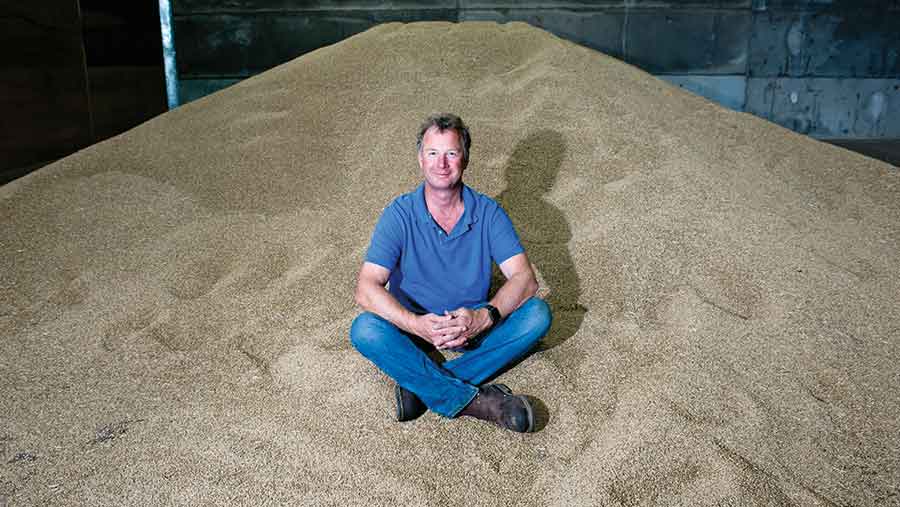2016 Farmers Weekly Awards: Arable Farmer finalists revealed
The Farmers Weekly Awards celebrate the very best of British farming by recognising and rewarding innovation, hard work and passion for agriculture.
Our three finalists are all running family enterprises which recognise that having healthy soils is the secret to a healthy arable business.
See also: Keep up to date with all the latest Farmers Weekly Awards news

From left: Andrew Howard, Guy Shelby and Josh Stratton
Andrew Howard
Brockhanger Farms, Kent
Andrew Howard has a clear vision – he aims to halve his fertiliser and pesticide inputs within five years while increasing crop productivity.
He believes this can be achieved by learning from pioneering farmers from around the world, such as Gabe Brown in North Dakota, who is leading the soil health movement.
And like Gabe, he is not afraid to try new things. “The one thing he told me is that if he does not have at least one failure a year, he is not trying hard enough,” Andrew says.

© Liz Finlayson Vervate
At the heart of his system is the focus on soil health and this affects every decision made on the family farm.
“With everything I do, the first question is how will this affect our soil? If we are going to damage soil, how can we mitigate the effects?”
He explains: “Soil is our main asset and improving soil health is how I believe we will improve productivity and profitability.”
Farm facts
- Arable area 345ha
- Cropping Milling wheat, winter barley, spring oats, triticale, winter and spring beans and spring linseed
- Staff Three (Andrew and his parents)
- Drills 3m John Deere 750a + 3m Simtech (for beans)
The changes started when he returned to the farm in 2003 after graduating at Cirencester. The suckler beef herd and sheep flock were sold off so he could concentrate on arable cropping and he now manages 345ha with help from his mother and father.
Cultivations were reduced and this culminated in Andrew switching to pure no-till farming five years ago and introducing more spring cropping, as the rotation was mainly winter varieties.
“We wanted to grow cover crops and manage grassweeds.”
He is starting to see the benefits, with improvements in soil health.
“Soils appear more black and structure is looking better.”
Yields average 9.5t/ha for wheat, and more than 5t/ha for winter beans, while spring oats achieve 6.5-7t/ha.
The next phase is to cut inputs. “It feels as if we are trying to carry the costs of two systems – the chemical and the biological.”
One way he is looking to make savings is through the use of a foliar microbial mix, which he brews himself and applies every time he sprays a fungicide. Costing just £3.45/ha, he explains that adding beneficial bugs helps to exclude pathogens.
Andrew is also looking at refining crop nutrition to boost plant health and hopes to improve N use efficiency. This year he is using black urea (urea coated with carbon), to cut losses into the atmosphere and into drains.
“Wheats do look cleaner, but I don’t know if this is down to better nutrition or biology, or a combination of both,” he says.
This season fertiliser has been cut by 10% and fungicide by 20% and over the next four years, the aim is to halve inputs by achieving more resilient crops.
He is also trialling different cropping mixes in the quest to find a low-cost break crop. Nine different mixes are being grown with no fertiliser inputs, such as linseed and oats. Growing mixes can reduce the risk of disease and pests, something he discovered on his travels as part of his Nuffield scholarship.
It’s not just reducing inputs – he also looks to add value where possible, with wheat for milling, oats for breakfast cereals and beans for seed as well as export to north African markets for human consumption.
He even created his own market opening with triticale. “Adas trials show it can deliver very high yields of 9-10t/ha, while needing less inputs than wheat.” But there was no market for it.
So he approached a local merchant and got together with several other growers and he supplies 500-600t to Fridays, a local poultry company.
The judges liked
- Passionate about cover crops and soil health
- Willing to trial new ideas and not afraid of failure
- Extensive technical knowledge of soil
Crop choice also helps in the fight against blackgrass, with double spring cropping breaks (beans and linseed) in difficult areas.
He is passionate about the environment and sees this as another benefit of his no-till farming system, with cover crops and voluntary margins providing habitats.
The family is also generating renewable energy with a solar PV park and the local community is benefiting from investment in local broadband.
His passion for learning and trying new things is helping other farmers through his extensive involvement in farmer groups, such as Biodiversity, Agriculture, Soil and Environment (Base), plus he is a member of a local group that benchmarks costs.
In conclusion, Andrew believes farming still has a positive future despite the challenge of having fewer pesticides and herbicides due to resistance and legislation.
“We are going to have to change from a system reliant on artificial inputs to being more self-reliant.”
Guy Shelby
Skirlaugh, East Yorkshire
Farming difficult soils at sea level and with blackgrass may sound like your worst nightmare, but Guy Shelby is not only getting on top of this grassweed – his system is delivering high yields.
He is a member of the 5t/ha oilseed rape club, wheat yields are into double digits and last year his beans averaged 7.5t/ha.

© Jim Varney
Guy puts part of this success down to his switch to strip-tillage three years ago combined with a greater focus on promoting soil health.
The 380ha family farm north of Hull consists of Holderness clay as well as areas known locally as “carr” land with high organic-matter soil lying over clay.
Farm facts
- Arable area 380ha
- Cropping Feed and milling wheat, winter and spring barley, oilseed rape, vining and blue peas
- Staff Guy plus his father and brother
- Drill 3m Mazuri strip-till
Each soil type has its challenges. The clay is difficult to work and the high organic content means pre-emergence residual chemistry has limited efficacy.
The changes started when Guy returned home from Harper Adams University. He had also spent time working in New Zealand and questioned the cultivation system being used back at home.
He first moved to a subsoiler-based system for establishing oilseed rape and rapidly saw benefits, including a jump in yield.
“I was doing the spraying and could see a difference. We were getting on fields sooner in the spring compared with the conventional tilled areas.”
This prompted him to look at reduced tillage and in 2013, he bought a 3m Mazuri strip-till drill.
“We are in an area where power harrowing is still king and many thought we were crazy after the wet year we just had. We liked the way it worked.”
One big benefit has been the cost saving, effectively halving establishment costs. “For example, the second wheat crop costs £90/ha to establish.
“At times we had four tractors in the same field. Now it is a one-man job,” he says.
Slugs can be a problem when growing oilseed rape, but Guy has found a way of managing them by making the most of cultural control.
“We tend to leave longer stubble in the rape to act as a slug habitat, which we then flail off with a topper. Then we run a [Vaderstad] Carrier to chit blackgrass and this disturbs the slug eggs.
“We try to do these 10 days apart on hot days to kill them.”
Pellets are then applied at drilling. “This approach seems to be controlling slugs.”
Guy is an adopter of technology, using yield mapping to variably adjust seed rates to achieve more even plant populations. He is also variably applying P and K.
Marketing wise, he sells one-third through pools, one-third forward and the rest is flexible to spread risk. Another part of his risk management is to grow four wheat varieties.
With cereals, Guy is looking to add value. “We traditionally grew a big heap of feed wheat, as the Vivergo biofuel plant is on our doorstep, which offers a £2-3/t premium.”
He is now moving to milling wheat and growing Skyfall this year for full milling spec. Guy is also trialling a 10ha area of malting barley.
Like many growers, he has a resistant blackgrass issue and has seen some success in managing it. A key part of his strategy is growing vining peas for Birds Eye in a one-in-six-year rotation.
The judges liked
- Enthusiatic and open to new ideas
- Excellent-looking crops
- Appears to be managing blackgrass
“This acts as a reset button, as it has to be established after ploughing. In-between, there are two wheats, spring or winter barley, oilseed rape and then back into peas.”
He highlights one field, where his blackgrass problem first started, which had more than 300 plants/sq m.
A combination of chemistry, cover cropping and growing spring crops has brought that down to 21/sq m, which is rougable.
The real challenge is on the carr land, where residuals don’t really do anything. He is currently growing a forage crop of turnips and rye for sheep grazing.
Environmentally, his higher level stewardship agreement has just ended and he will soon join the higher tier stewardship scheme.
He is passionate about shooting and believes this goes hand in hand with wildlife – providing habitats. He takes pride in seeing buzzards, kestrels and barn owls and is keen to provide different habitats.
Looking ahead, he believes the system is more sustainable and even in the three years since he started strip-tilling, soils have improved.
His vision is to take on more land and he has raised his yield targets.
“We achieved yields of 12t/ha last year and now hope to set that as our benchmark average.”
Josh Stratton
East Farm, Wiltshire
Josh Stratton loves spreadsheets. He has a crop margin calculator, a machinery cost spreadsheet and even one recording what butterfly species have been surveyed on one of the farm’s sites of special scientific interest (SSSI).
Having information at his fingertips means he knows exactly what his costs are and where he is in relation to budget.

© Hugh Nutt
Importantly, it helps him get the most from every hectare on the family farm on the edge of Salisbury Plain.
This is especially important as arable cropping has to compete with the other enterprises, including the 400-cow dairy and the 3.7MW anaerobic digester.
Farm facts
- Arable area 1,100ha
- Cropping Feed wheat, winter malting barley, spring malting barley, oilseed rape and spring oats
- Staff Three + harvest help
- Drill 6m Amazone Cayena 6001
“Every part of the farm has to fight for survival as there are competing uses for our land from the anaerobic digester, dairy, youngstock rearing and cropping. Crops are grown where it makes the best use of land.”
To drive the arable business forward, Josh has switched to direct drilling this season, the next stage in the process of reducing cultivations. It started with the plough being ditched 15 years ago in favour of shallow cultivations.
“Soil health was the reason we moved to direct drilling and we don’t want to be doing recreational tillage,” he says.
“Ultimately, we want to benefit soil flora and fauna by doing less.”
Another reason was the loss of grazing from the rotation following the reorganisation of the dairy enterprise. “It was harder work to get a good crop and we started to see weed problems coming in.”
Another measure to help soil health was the adoption of permanent tramlines with controlled traffic farming, operating on a 12m combine with 24m sprayer tramlines and the same width digestate dribble bar.
“We got rid of the straw merchant and contractors and started to chop and incorporate all straw.” Cover crops are now being trialled as a possible means of helping soil health.
One resource at hand is a plentiful supply of anaerobic digestate, applied to grazing and arable land. This season, it replaced 60% of total bagged nitrogen and will rise to 80% next year.
Josh is still learning how to get the most from it and in this second season, he has found he needs to top up with some bagged sulphur.
“Tissue testing did show a sulphur deficiency and it was related to areas that received digestate.”
Timings have also been tweaked, as digestate is slower to release the nitrogen than bagged fertiliser.
The light chalkland is ideal barley country and he is adding value by growing both winter and spring malting barley for Molson Coors and 180ha of Null-lox barley for Carlsberg and Heineken. Null-lox varieties have been bred not to have a certain enzyme, to produce fresher-tasting beer.
Josh is also adding value to oats by supplying Morning Foods, but it is not milling wheat land and instead he grows barn-busting feed wheat for local poultry company Faccenda.
Wheat averages 10.1t/ha, winter barley 8t/ha, spring barley 7.6t/ha, oats 7.7t/ha and oilseed rape 4t/ha. Oilseed rape is still a profitable crop, with no real problems with flea beetle.
Marketing is carried out through Salisbury Cereals, a local co-op with 20 farmer members that trades 35,000t of crop. Josh is a passionate believer in co-ops and sits on the board.
The judges liked
- Detailed knowledge of costs and budgets
- Crops looking good in a challenging season
- Zero tolerance of blackgrass
All crops go into a pool and the co-op has hired a dedicated trader to sell it on behalf of members. The trader has also been instrumental in finding premium market opportunities with brewers.
Josh has a keen interest in the environment and is in a higher level stewardship scheme as part of a cluster of farms. The farm also has three SSSIs, with an abundance of pollinators, butterflies and, on one site, orchids.
The river Wylye runs through the farm and Josh is about to embark on a project to rewild it by flattening banks and introducing bends to help promote wildlife and fish.
He interacts with the wider public and hosts visits by schools and other community groups, although the renewable energy plant is the main focus.
In the not too distant future, East Farm could be augmenting the cropping mix with more exotic additions.
“We are looking to build glasshouses to use the waste heat and carbon dioxide from the digester and grow higher value crops such as cut flowers and vegetables.”
 The Farmers Weekly Arable Farmer of the Year 2016 award is sponsored by Frontier.
The Farmers Weekly Arable Farmer of the Year 2016 award is sponsored by Frontier.
The finalists are thinking strategically, looking at fixed costs and changing systems to find new solutions to challenges. Soil improvement is key, with reduced cultivations and new drilling technology used alongside rotations and cover or catch crops. Their optimism was clear.”
Charlie Whitmarsh, crop production director

